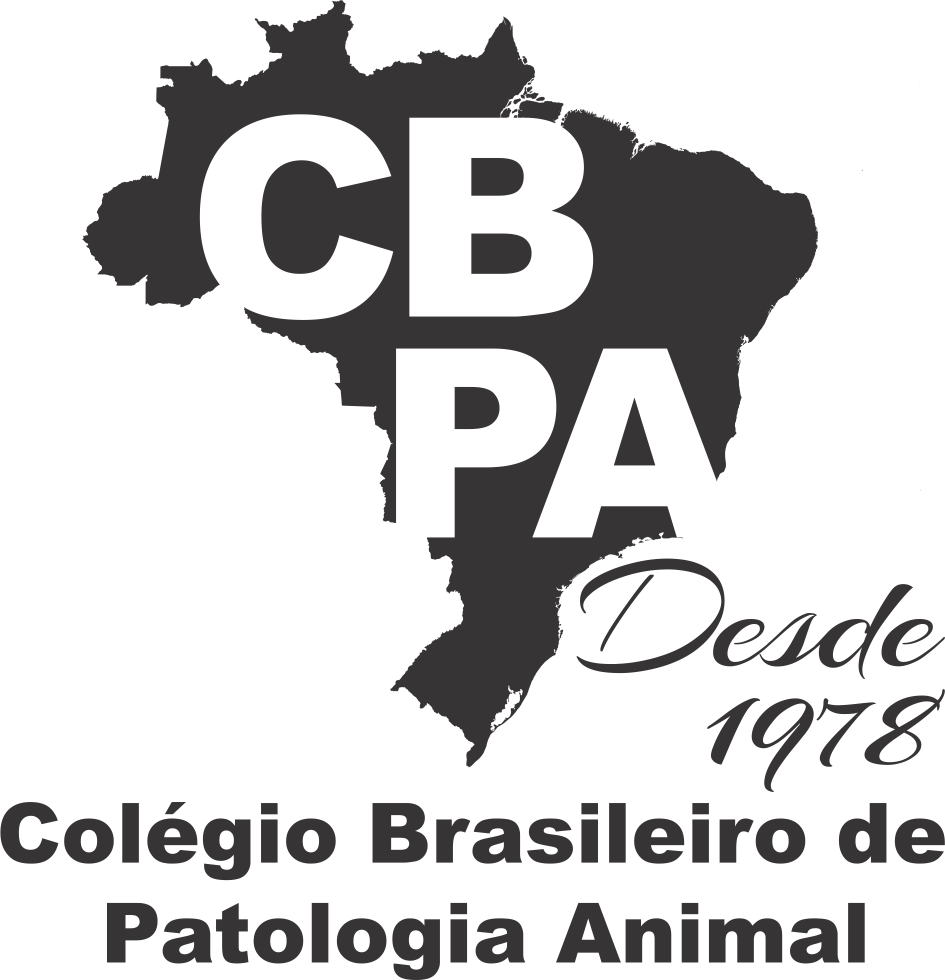Resultado da pesquisa (749)
Termo utilizado na pesquisa Brazil
#1 - Sarcocystis neurona, Toxoplasma gondii, and Neospora caninum infection in bovine fetuses from a slaughterhouse in southern Brazil
Abstract in English:
This study aims to describe the molecular detection of Sarcocystis neurona, Toxoplasma gondii, and Neospora caninum in brain samples obtained from bovine fetuses at a slaughterhouse in South Brazil. Brain samples from 35 fetuses of asymptomatic pregnant beef cows underwent nested polymerase chain reaction (PCR) to amplify a fragment of the 18S rRNA gene specific to S. neurona, T. gondii, and N. caninum. The amplicons were subjected to a two-step digestion process: first, with the restriction enzyme DdeI, which differentiates N. caninum from T. gondii and S. neurona; and subsequently, with the HpaII enzyme, to distinguish S. neurona from T. gondii and N. caninum. Of the 35 brain samples tested, 26 yielded positive PCR results for the 18S rRNA gene. Of these, 23 were digested with restriction enzymes, yielding 17 positive samples for S. neurona, five for N. caninum, and one for T. gondii. Specific primers for S. neurona, N. caninum, and T. gondii were employed to confirm the restriction fragment length polymorphism results. DNA sequencing and phylogenetic analysis, based on the ITS-1 region, were conducted on a positive sample for S. neurona, confirming our surprising findings. The sequence from fetus 75 exhibited a high nucleotide identity (97.79%) and clustered with S. neurona sequences available in GenBank. Molecular analyses confirmed the unprecedented detection of S. neurona, a protozoan not previously reported in cattle, in bovine fetal brain samples, thereby underscoring the necessity for further research on Apicomplexa protozoan infections in cattle.
Abstract in Portuguese:
Este estudo tem como objetivo descrever a detecção molecular de Sarcocystis neurona, Toxoplasma gondii e Neospora caninum em amostras de cérebro obtidas de fetos bovinos em um matadouro no Sul do Brasil. Amostras de cérebro de 35 fetos de vacas gestantes assintomáticas foram submetidas à reação em cadeia da polimerase (PCR) aninhada para amplificar um fragmento do gene 18S rRNA específico para S. neurona, T. gondii e N. caninum. Os amplicons foram submetidos a um processo de digestão em duas etapas: primeiro, com a enzima de restrição DdeI, que diferencia N. caninum de T. gondii e S. neurona; e posteriormente, com a enzima HpaII, para distinguir S. neurona de T. gondii e N. caninum. Das 35 amostras de cérebro testadas, 26 apresentaram resultados positivos na PCR para o gene 18S rRNA. Destas, 23 foram digeridas com enzimas de restrição, resultando em 17 amostras positivas para S. neurona, cinco para N. caninum e uma para T. gondii. Primers específicos para S. neurona, N. caninum e T. gondii foram empregados para confirmar os resultados do polimorfismo de comprimento de fragmentos de restrição. Sequenciamento de DNA e análise filogenética, baseada na região ITS-1, foram realizados em uma amostra positiva para S. neurona, confirmando nossos resultados surpreendentes. A sequência do feto 75 apresentou uma alta identidade de nucleotídeos (97,79%) e se agrupou com sequências de S. neurona disponíveis no GenBank. As análises moleculares confirmaram a detecção inédita de S. neurona, um protozoário não anteriormente relatado em bovinos, em amostras de cérebro fetal bovino, destacando assim a necessidade de mais pesquisas sobre infecções por protozoários do filo Apicomplexa em bovinos.
#2 - Abamectin poisoning in adult beef cattle and calves in northern and midwestern Brazil
Abstract in English:
Abamectin is an anthelminthic widely used in agriculture, human, and veterinary medicine. The predomination in cases of abamectin toxicosis are neurological changes such as ataxia, lethargy, coma, tremors, convulsions, mydriasis, and blindness. This article describes the clinical, morphological, and toxicological results of cattle accidentally poisoned by abamectin on properties in the states of Rondônia and Mato Grosso, Brazil. Clinical and epidemiological data on the affected herd were collected from the owners, employees, and veterinarians of the properties. A clinical examination was conducted, and a necropsy was performed on the affected animals, with organ samples collected for histological and toxicological analysis. The main clinical signs observed were ataxia, apathy, and death. No significant gross or histologic changes were present. The concentration of abamectin in the brains and livers was > 25.00 μg/kg. The predisposing factors for the occurrence of these outbreaks were visual estimation of cattle weight, standardization of medication doses for batches of cattle, and medication bottle error during application resulting in poisoning and death of cattle. The findings emphasize the need to improve animal management and team training prior to drug application in properties.
Abstract in Portuguese:
Abamectina é um medicamento amplamente utilizado na agricultura, medicina humana e veterinária. Na intoxicação por abamectina predominam alterações neurológicas como ataxia, letargia, coma, tremores, convulsões, midríase e cegueira. Este trabalho descreve os achados clínicos, morfológicos e análises toxicológicas em bovinos de corte acidentalmente intoxicados por abamectina nos Estados de Rondônia e de Mato Grosso, Brasil. Histórico, dados epidemiológicos e informações clínicas foram colhidos com proprietários, colaboradores e médicos veterinários nas propriedades. Foi realizado exame clínico nos bovinos e posteriormente, necropsia com colheita de amostras dos órgãos para análise histológica e toxicológica. Os principais sinais encontrados foram ataxia, apatia e morte. Não foram notadas alterações morfológicas significativas. A concentração de abamectina nos encéfalos e fígados foi > 25,00 μg/kg. Fatores predisponentes para a ocorrência desses surtos foram a estimativa visual de peso dos bovinos, padronização de doses do medicamento para os lotes e erro de frasco do medicamento durante a aplicação. Os achados enfatizam a necessidade de melhorias no manejo animal e treinamento da equipe antes do período de aplicação de medicamentos nas propriedades.
#3 - The importance of veterinary diagnostic laboratories for disease surveillance, research, and postgraduate studies in animal health in Brazil
Abstract in English:
This article describes the importance of Veterinary Diagnostic Laboratories (VDLs) for the development of animal health research and postgraduate education in Brazil. It also addresses the limitations, difficulties, and potential of these laboratories as an efficient alternative for the consolidation of epidemiological surveillance of animal diseases in the country. These laboratories should also be used as efficient tools for the development of research, teaching, and extension, practiced in an associated manner in undergraduate and postgraduate education in veterinary medicine.
Abstract in Portuguese:
Este artigo descreve a importância dos Laboratórios de Diagnóstico Veterinário (LDVs) para o desenvolvimento da pesquisa em saúde animal e do ensino de pós-graduação no Brasil. Aborda também as limitações, dificuldades e potencialidades desses laboratórios como alternativa eficiente para a vigilância epidemiológica de doenças animais no país. Esses laboratórios também devem ser utilizados como ferramenta eficiente para o desenvolvimento da pesquisa, ensino e extensão, praticados de forma associada, no ensino de graduação e pós-graduação em medicina veterinária.
#4 - Leishmania enriettii in guinea pig (Cavia porcellus) in southern Brazil
Abstract in English:
Leishmaniasis is a parasitic disease with a worldwide distribution, transmitted to animals and humans through the blood meal of sand flies, caused by protozoa of the genus Leishmania. This report aims to describe the clinical, pathological, and molecular findings of mucocutaneous leishmaniasis caused by Leishmania enriettii in a guinea pig (Cavia porcellus). The animal presented ulcerated skin lesions in the right pinna. Samples from the lesion were evaluated by cytology, revealing the presence of amastigote forms of Leishmania spp. Histopathology showed a dermal inflammatory infiltrate consisting of macrophages, multinucleated giant cells, lymphocytes, plasma cells, and heterophils. The foam cells contained parasitophorous vacuoles filled with amastigotes. Molecular characterization identified the species as L. enriettii. The diagnosis of mucocutaneous leishmaniasis was based on morphological findings (macroscopic and microscopic) associated with molecular biology tests that allowed defining the etiological agent of the disease.
Abstract in Portuguese:
A leishmaniose é uma doença parasitária com distribuição mundial, transmitida a animais e humanos através do repasto sanguíneo de flebotomíneos, causada por protozoários do gênero Leishmania. Este relato tem como objetivo descrever os achados clínicos, patológicos e moleculares da leishmaniose mucocutânea causada por Leishmania enriettii em cobaias (Cavia porcellus). O animal apresentava lesões cutâneas ulceradas no pavilhão auricular direito. Amostras da lesão foram avaliadas por citologia, revelando a presença de formas amastigotas de Leishmania spp. A histopatologia mostrou um infiltrado inflamatório dérmico composto por macrófagos, células gigantes multinucleadas, linfócitos, plasmócitos e heterófilos. As células espumosas continham vacúolos parasitóforos cheios de amastigotas. A caracterização molecular identificou a espécie como L. enriettii. O diagnóstico da leishmaniose mucocutânea foi baseado em achados morfológicos (macroscópicos e microscópicos) associados a testes de biologia molecular que permitiram definir o agente etiológico da doença.
#5 - Phylogenetic analysis of Sporothrix brasiliensis isolated from feline sporotrichosis on São Luís Island, Maranhão, Brazil
Abstract in English:
Sporotrichosis is a zoonotic cutaneous mycosis caused by saprophytic fungi of the Sporothrix, affecting cats, horses, dogs, and humans. This study aimed to evaluate sporotrichosis in cats clinically and to phenotypically characterize and molecularly characterize Sporothrix species on São Luís Island, Maranhão, Brazil. From October 2022 to July 2023, clinical assessments and cytological examinations were performed on suspected feline sporotrichosis cases at the Francisco Edilberto Uchôa Lopes Veterinary Hospital, State University of Maranhão. Lesion exudates were collected via exfoliation or imprinting for fungal culture and species identification. Fungal cultures underwent species-specific polymerase chain reaction (PCR), genetic sequencing, and phylogenetic analysis. A total of 46 cats (33 males and 13 females) were assessed. Disseminated cutaneous sporotrichosis was observed in 70% of cases, with lesions predominantly on the face, ears, thoracic regions, and limbs. Initially, white fungal cultures gradually turned blackish with a coriaceous texture characteristic of Sporothrix spp. PCR amplification of the calmodulin (CAL) gene using Sporothrix brasiliensis-specific primers confirmed all 46 samples as S. brasiliensis. Phylogenetic analysis revealed genetic identity rates ranging from 90% to 100% with S. brasiliensis sequences. This seems to be the first molecular confirmation of S. brasiliensis causing feline sporotrichosis on São Luís Island.
Abstract in Portuguese:
A esporotricose é uma micose cutânea zoonótica causada por fungos saprófitas pertencentes ao gênero Sporothrix que acomete gatos, cavalos, cães e humanos. Este estudo teve como objetivo avaliar clinicamente a esporotricose em gatos e caracterizar fenotípica e molecularmente as espécies de Sporothrix sp. na ilha de São Luís, estado do Maranhão, Brasil. De outubro de 2022 a julho de 2023, avaliações clínicas e exames citológicos foram realizados em casos suspeitos de esporotricose felina no Hospital Veterinário Francisco Edilberto Uchôa Lopes, Universidade Estadual do Maranhão. Exsudados de lesões foram coletados por esfoliação ou imprint para cultura fúngica e identificação de espécies. As culturas fúngicas foram submetidas à reação em cadeia em polimerase (RCP) espécie-específica, sequenciamento genético e analise filogenética. Um total de 46 gatos (33 machos e 13 fêmeas) foram avaliados. Esporotricose cutânea disseminada foi observada em 70% dos casos, com lesões predominantemente na face, orelhas, regiões torácicas e membros. Inicialmente, culturas fúngicas brancas gradualmente tornaram-se enegrecidas com uma textura coriácea característica de Sporothrix spp. A amplificação por PCR do gene calmodulina (CAL) usando primers específicos de Sporothrix brasiliensis confirmou todas as 46 amostras como S. brasiliensis. A análise filogenética revelou taxas de identidade genética variando de 90% a 100% com sequências de S. brasiliensis. Esta parece ser a primeira confirmação molecular de S. brasiliensis causando esporotricose felina na Ilha de São Luís.
#6 - Bovine abortion caused by Ureaplasma diversum infection in Midwest Brazil
Abstract in English:
Ureaplasma diversum has been reported to infect the respiratory and genital systems in cattle, leading to numerous reproductive alterations, including abortions. However, detailed and comprehensive studies of fetal pathology in naturally infected cases are lacking in the scientific literature to this date. Therefore, this study describes the pathological lesions in three fetuses spontaneously aborted by three heifers naturally infected with U. diversum localized in three municipalities from Mato Grosso State, Brazil. The fetal necropsy revealed diffusely reddened and unexpanded lungs. Histologically, diffuse moderate subacute to chronic neutrophilic and histiocytic bronchointerstitial pneumonia with bronchial-associated lymphoid tissue hyperplasia. U. diversum was identified in fetal tissues by molecular approaches and sequencing. To our knowledge, this is the first description of bovine abortion caused by U. diversum infection in the Midwest of Brazil.
Abstract in Portuguese:
Ureaplasma diversum infecta os sistemas respiratório e genital de bovinos, levando a várias alterações reprodutivas, inclusive abortos. No entanto, até o momento, não há na literatura científica, estudos detalhados e abrangentes no Brasil sobre as lesões fetais em casos naturalmente infectados. Portanto, este artigo descreve as lesões em três fetos espontaneamente abortados por três novilhas naturalmente infectadas por U. diversum localizadas em três municípios do estado de Mato Grosso, Brasil. A necropsia fetal revelou pulmões difusamente avermelhados e não expandidos. Histologicamente, havia pneumonia neutrofílica e histiocítica broncointersticial subaguda a crônica difusa e moderada com hiperplasia do tecido linfoide associado aos brônquios. U. diversum foi identificado em tecidos fetais após a realização de técnicas moleculares e sequenciamento. Esta parece ser a primeira descrição de aborto bovino causado por infecção por U. diversum na região Centro-Oeste do Brasil.
#7 - Mycoplasma spp. in Psittaciformes kept as pets in the southwestern Amazon of Brazil
Abstract in English:
Mycoplasmosis, caused by Mycoplasma spp., is a disease of great importance in birds, especially in the poultry industry. They are considered emerging bacteria that cause subclinical and clinical diseases in various birds and should not be ruled out as responsible for infections in Psittaciformes. Their development may go unnoticed, given their slow evolution, which ends up generating difficulties in the diagnosis and treatment of these animals. Thus, this research aims to detect the presence of Mycoplasma spp. in Psittaciformes kept as pets in the southwestern Amazon of Brazil. The animals in the study were kept as pets and were selected based on convenience criteria. Biological material was collected using swabs from the oral and cloacal cavities of 100 birds. Subsequently, PCR was performed in all samples to identify Mycoplasma spp. The results demonstrated the presence of DNA from Mycoplasma spp. in 7% (7/100) of the biological samples of the investigated Psittaciformes.
Abstract in Portuguese:
A micoplasmose aviária, causada por Mycoplasma spp. é uma enfermidade de grande importância nas aves, principalmente na indústria avícola. São consideradas bactérias emergentes, que causam doenças subclínicas e aparentes em diversas aves, e não devem ser descartadas como responsáveis por infecções em Psittaciformes. O desenvolvimento pode passar despercebido, dado o seu caráter de evolução lenta, o que acaba por gerar uma dificuldade no diagnóstico e no tratamento desses animais. Dito isto, esta pesquisa tem como objetivo detectar a presença de Mycoplasma spp. em Psittaciformes mantidos como pet na Amazônia Sul Ocidental do Brasil. Os animais do estudo eram criados como pets e a seleção se deu por critério de conveniência. Foram realizadas coletas de material biológico com swabs na cavidade oral e cloacal em 100 aves. Posteriormente, foi processado o PCR para identificação de Mycoplasma spp. em todas as amostras. Os resultados demonstraram a presença de DNA da bactéria Mycoplasma spp. em 7% (7/100) das amostras biológicas dos Psittaciformes investigados.
#8 - Metastatic gallbladder adenocarcinoma and peritonitis as the cause of death in one of the world’s oldest captive jaguars (Panthera onca) in southern Brazil
Abstract in English:
A 25-year-old captive female jaguar (Panthera onca) presented with clinical signs of anorexia, adipsia, vomiting, and difficulty moving that progressed over a duration of three days. This eventually led to death. During necropsy, a significant amount of brown fluid was detected in the abdominal cavity. The gallbladder was markedly enlarged, diffusely distended with thickened walls, and had an irregular mucosa ranging from black to white. Bile spilled into the abdominal cavity through a rupture in the wall. Additionally, a focally extensive, 7 x 5 x 3 cm, white mass with adherent friable brown material was observed in the mucosa. A 2 x 2 x 1 cm, firm white nodular mass was present in the extrahepatic bile duct and caused obstruction of the bile passage. Histopathologic evaluation confirmed adenocarcinoma of the gallbladder and adjacent ducts. The neoplasm was arranged as acini and tubules and supported by abundant fibrovascular stroma. Metastases were observed in the liver, intestines, and lungs. Several other tumors were identified in this jaguar. These included papillary carcinomas of the ovaries, fibroleiomyomas in the uterus, leiomyomas in the stomach, and follicular adenomas in the thyroid gland. Chronic kidney disease and moderate dilated cardiomyopathy were also observed. Immunohistochemistry showed positive staining for pan-cytokeratin in the neoplastic cells of the gallbladder, ovary, and thyroid gland. Positive staining for vimentin was observed in the neoplastic cells of the uterus and stomach. The identification of multiple tumors in this aged jaguar highlights the need for routine examinations throughout life for early detection and management of tumors.
Abstract in Portuguese:
Uma onça-pintada (Panthera onca) fêmea de 25 anos em cativeiro apresentou sinais clínicos de anorexia, adipsia, vômito e dificuldade de locomoção, que progrediram ao longo de três dias, levando a morte. Durante a necropsia, foi detectada uma quantidade significativa de fluido marrom na cavidade abdominal. A vesícula biliar estava significativamente aumentada, difusamente distendida com paredes espessadas e apresentava mucosa irregular, variando de preto a branco. Bile havia extravasado para a cavidade abdominal devido a uma ruptura na parede. Além disso, foi observada uma massa branca, focalmente extensa, medindo 7 x 5 x 3 cm, com material marrom friável aderido à mucosa. Uma massa nodular branca, firme, de 2 x 2 x 1 cm, estava presente no ducto biliar extra-hepático, causando obstrução da passagem da bile. A avaliação histopatológica confirmou adenocarcinoma de vesícula biliar na vesícula e nos ductos adjacentes. A neoplasia estava organizada em ácinos e túbulos, sustentada por estroma fibrovascular abundante. Metástases foram observadas no fígado, intestinos e pulmões. Vários outros tumores também foram identificados nessa onça-pintada, incluindo carcinomas papilíferos nos ovários, fibroleiomioma no útero, leiomioma no estômago e adenoma folicular na glândula tireoide. Doença renal crônica e cardiomiopatia dilatada moderada também foram constatadas. A imuno-histoquímica revelou marcação positiva para pancitoqueratina nas células neoplásicas da vesícula biliar, ovário e glândula tireoide. Marcação positiva para vimentina foi observada nas células neoplásicas do útero e estômago. A identificação de múltiplos tumores nessa onça-pintada idosa destaca a importância de exames de rotina ao longo da vida para a detecção precoce e manejo de neoplasias.
#9 - Epidemiology of toxoplasmosis in felids and canids in Brazil: A brief One Health overview
Abstract in English:
Toxoplasmosis is a disease caused by the obligate intracellular protozoan Toxoplasma gondii, which infects animals and humans worldwide. Felids are definitive hosts that eliminate oocysts, contaminating the environment, food, and water. Among carnivores, cats are the most important hosts for the epidemiology of the disease since a single individual can shed millions of oocysts. Wild canids are considered sentinels and play an essential role in the epidemiology of toxoplasmosis due to tissue cysts in muscle cells, representing a source of infection for carnivores through predation, while environmental contamination is mainly due to oocyst shedding by felids. Free-ranging felids are more likely to be infected by T. gondii than felids living in captivity. The free-living wild canids have lower seropositivity compared to canids in captivity. This review article presents epidemiological data on toxoplasmosis in domestic and wild carnivores in Brazil, targeting professionals in clinical practice, veterinary pathology, diagnostics, and One Health. Therefore, we understand the importance of disseminating diagnoses, epidemiological investigations and animal health programs to control, prophylaxis and treat toxoplasmosis in domestic and wild carnivores.
Abstract in Portuguese:
A toxoplasmose é uma doença causada pelo protozoário intracelular obrigatório Toxoplasma gondii, responsável por infectar animais e seres humanos em todo o mundo. Os felinos são hospedeiros definitivos e eliminam oocistos que contaminam o ambiente, alimentos e água. Dentre os carnívoros, os felinos são os hospedeiros mais importantes para a epidemiologia da doença, visto que um único indivíduo é capaz de excretar milhões de oocistos. Canídeos selvagens são considerados sentinelas e desempenham um papel essencial na epidemiologia da toxoplasmose, pois os cistos teciduais presentes nas células musculares representam uma fonte de infecção para carnívoros por meio da predação, enquanto a contaminação ambiental ocorre principalmente pela eliminação de oocistos por felídeos. Os felinos de vida livre têm maior probabilidade de serem infectados por T. gondii do que os felinos mantidos sob cuidados humanos. Os canídeos silvestres de vida livre apresentam menor soropositividade em comparação aos canídeos em cativeiro. Este artigo de revisão apresenta dados sobre a epidemiologia da toxoplasmose em carnívoros domésticos e silvestres no Brasil focado para profissionais da área clínica, patologia veterinária, diagnóstico e Saúde Única. Portanto entendemos a importância de divulgação de métodos de diagnósticos, investigações epidemiológicas e programas de saúde animal para contribuir com o controle, profilaxia e tratamento da toxoplasmose em carnívoros domésticos e silvestres.
#10 - Bluetongue in sheep in the state of Santa Catarina, Brazil: seroepidemiologic, clinical, and pathological findings
Abstract in English:
This study aimed to investigate the circulation of bluetongue virus (BTV) in sheep throughout different regions of the state of Santa Catarina by the serologic agar gel immunodiffusion (AGID) assay and to describe the clinical, pathological, and epidemiologic aspects of seven outbreaks and three isolated cases, which occurred between 2009 and 2019. The state was divided into three regions for research into antibodies. The average annual temperatures and altitudes of the regions were described or tabulated. Blood samples were collected from sheep on 24 properties in 16 municipalities distributed throughout the three aforementioned regions. Of the 388 blood samples collected from the sheep, 250 were seropositive (64.4%) in the AGID test. Antibodies against BTV were detected in the three regions. The disease was diagnosed through clinical signs and macroscopic lesions and confirmed by the reverse transcription polymerase chain reaction (RT-PCR) technique. The affected sheep developed ulcerations in the nostrils, lips, and oral mucosa with crusting, locomotor difficulties, black diarrhea, coughing, and regurgitation, followed by death. The necropsy showed multiple ulcers in the palate and rumen, petechial hemorrhages in the serosa of the esophagus near the esophageal hiatus, and focal hemorrhages in the pulmonary artery. In Santa Catarina, bluetongue in sheep is a seasonal disease that occurs mainly during the hot, rainy seasons (December to April). Seasonality coincides with the time of year when Culicoides vectors have the highest population and metabolic activity.
Abstract in Portuguese:
Este estudo teve como objetivos investigar, por meio do teste sorológico de imunodifusão em gel de ágar (IDGA), a circulação do vírus da língua azul (BTV) em ovinos em diferentes regiões do estado de Santa Catarina e, descrever os aspectos clínico-patológicos e epidemiológicos de sete surtos e três casos isolados, ocorridos entre os anos de 2009 a 2019. Para a pesquisa de anticorpos, o estado foi dividido em três regiões. As temperaturas médias anuais e altitudes das regiões foram descritas ou tabuladas. Foram coletadas amostras de sangue de ovinos em 24 propriedades de 16 municípios distribuídos nas três regiões estabelecidas. Dos 388 ovinos coletados, 250 foram soropositivos (64,4%) no teste de IDGA. Anticorpos contra o BTV foram detectados nas três regiões. A enfermidade foi diagnosticada pelos sinais clínicos, lesões macroscópicas e confirmada pela técnica de reação em cadeia da polimerase com transcrição reversa (RT-PCR). Os ovinos afetados desenvolveram ulcerações nas narinas, lábios e mucosa oral com formação de crostas, dificuldade de locomoção, diarreia enegrecida, tosse e regurgitamento seguido de morte. Na necropsia foi observado principalmente múltiplas úlceras no palato e rúmen, hemorragias petequiais na serosa do esôfago próximo ao hiato esofágico e hemorragia focal na artéria pulmonar. Em Santa Catarina, a língua azul em ovinos é uma doença sazonal, que ocorre principalmente em épocas quentes e chuvosas (dezembro a abril). A sazonalidade coincide com a época do ano a qual os vetores Culicoides apresentam maior população e atividade metabólica.








